Eight days in the central Ruahine Range. Eight days in the wild; eight days when we saw no other people, knew nothing of what was happening in the outside world, saw no buildings other than the huts we stayed in, heard no vehicles other than an occasional, distant aeroplane glinting high and tiny overhead, going somewhere irrelevant. 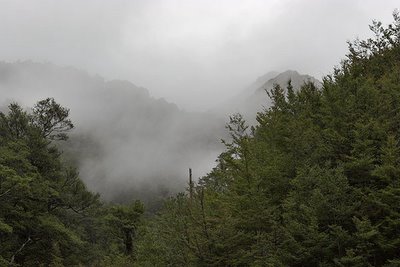 By the time we returned from the hills I’d already become unaccustomed to a predominance of human activities—driving back, I realised how strongly I was aware of houses, roads, fences, sheds, vehicles, domestic stock, exotic trees, and the other innumerable reminders of what we call the ‘civilised’ world. The act of driving, of sitting in a comfortable seat being whizzed along a back country road by an enormous mass of metal, seemed unreal, almost absurd. The following day, Friday, I drove into town to meet friends and couldn’t believe the amount of traffic on the road. Yet, it was no more than a typical Friday evening and Palmerston North’s hardly a giant metropolis. I guess that’s what eight days in the wild does to you.
By the time we returned from the hills I’d already become unaccustomed to a predominance of human activities—driving back, I realised how strongly I was aware of houses, roads, fences, sheds, vehicles, domestic stock, exotic trees, and the other innumerable reminders of what we call the ‘civilised’ world. The act of driving, of sitting in a comfortable seat being whizzed along a back country road by an enormous mass of metal, seemed unreal, almost absurd. The following day, Friday, I drove into town to meet friends and couldn’t believe the amount of traffic on the road. Yet, it was no more than a typical Friday evening and Palmerston North’s hardly a giant metropolis. I guess that’s what eight days in the wild does to you. ...
Perhaps “home” is the art of feeling at ease where you are, regardless of whether it’s where you intended to be. If so—as I believe it to be—then Triangle Hut was the first of several homes during the trip; or maybe it was the beginning of a continuous exploration of a particular form of home. I can’t honestly say I’d felt particularly at home during the first night: we’d spent it bivvying on the tops in the dense mist and persistent rain but at least we were sheltered from the worst of the wind. Surprisingly, we both slept much of the night and—because the weather didn’t relent—most of the morning too. Luckily the drizzle eased by lunchtime, allowing us to struggle out of our bags like hatching stick insects, pack up without saturating everything, and descend to Triangle to wait out the weather instead of carrying on to Pourangaki Hut.
We spent two nights at Triangle, teased by the weather which cleared to reveal a starry sky the evening we arrived, but clouded over again during the night. I woke at dawn as gusts of wind shook the walls, raining leaves and twigs on the roof; once or twice I saw the cloud break into layers: swift, grey, fast-moving veils low down; lighter, relatively static cloud higher up. We read, dried damp gear, drank tea, enjoyed long sessions of yarning, collected large amounts of firewood, and watched the sporadic showers become persistent drizzle. Late in the afternoon—too late to pack and head for the tops—the weather cleared. That evening we heard whio whistling in the river; probably two birds, but it was too dark to check. We’d heard them briefly the first night, but never did get to see them. Somehow it didn’t matter; it was enough to hear that marvellous whistle and know they were out there, close by. It felt like a message from very special friends.
And, at 5:20 a.m. on the second morning at Triangle, not long after night had begun to lighten into day, I heard them again.  Shortly after, a ruru began calling, close outside the hut. I lay in my sleeping bag, warm, comfortable, only half awake, caught up in the sounds—two of my favourite birds; the river rushing nearby... even better looking up through the skylight and realising the grey cloud signalled no urgency to try for the tops. Later, John emerged from his bag and went outside. He returned saying it was raining. Wonderful. I dozed for a while, then got up and made porridge and a brew. We read much of the morning, and when the weather finally looked as if it might clear, began packing.
Shortly after, a ruru began calling, close outside the hut. I lay in my sleeping bag, warm, comfortable, only half awake, caught up in the sounds—two of my favourite birds; the river rushing nearby... even better looking up through the skylight and realising the grey cloud signalled no urgency to try for the tops. Later, John emerged from his bag and went outside. He returned saying it was raining. Wonderful. I dozed for a while, then got up and made porridge and a brew. We read much of the morning, and when the weather finally looked as if it might clear, began packing.
We climbed steadily, reaching the top and the inside of the cloud after about two hours. We sidled to the main Whanahuia Range, through drenched snowgrass, past the skeleton of a stag—shreds of half-mummified, half-putrefied flesh and hair still clinging to white bones. The back legs were missing; the vertebrae had begun to disarticulate. A cold, drizzling mist blew by as we walked on, past small tarns, across the East face of Mangamahue, across the saddle with its rusting rain gauge and eventually to where the ridge forked. Immediately before us, steep bluffs fell away into the mist. 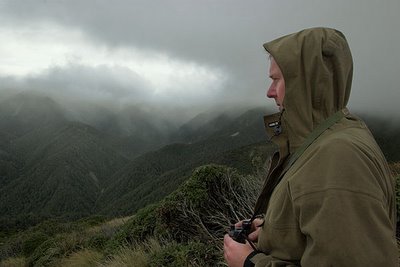 Somewhere hidden down there the Pourangaki surged through dark beech forest; somewhere down there, Pourangaki Hut promised relief from heavy packs and respite for weary legs. We turned left, followed the edge of the bluffs and soon after arrived at the top of the spur where the track descended to the hut. By then our world had a radius of about 100 m and included nothing other than saturated snowgrass, small, low, subalpine plants, and mist that enveloped everything like a blindness. But within 20 minutes we’d descended below the cloud into a high, wild, and beautiful world; the kind of environment that says slow down, linger, look around, enjoy this.
Somewhere hidden down there the Pourangaki surged through dark beech forest; somewhere down there, Pourangaki Hut promised relief from heavy packs and respite for weary legs. We turned left, followed the edge of the bluffs and soon after arrived at the top of the spur where the track descended to the hut. By then our world had a radius of about 100 m and included nothing other than saturated snowgrass, small, low, subalpine plants, and mist that enveloped everything like a blindness. But within 20 minutes we’d descended below the cloud into a high, wild, and beautiful world; the kind of environment that says slow down, linger, look around, enjoy this.
We did.
Although the weather was still misty, damp, and marginal the next day, we decided to head for Waterfall Hut in the Kawhatau Valley, as the route is well defined—a long, steep climb up a good track and a narrow spur; a short section along the main ridge; then a steep descent into Pinnacle Creek, which joins the Kawhatau not far from the Hut. At times, the view over the Pourangaki catchment was nothing short of spectacular, the hazy mist and veils of patchy rain giving the ridges a beautiful, almost ethereal, aerial perspective. Later in the trip we’d see the same views under a perfect blue sky, and, ironically, something seemed to be missing. 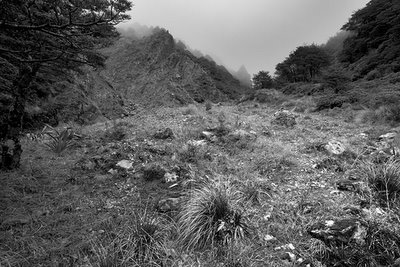 Perhaps the fact that so much less is hidden means there’s less sense of mystery, less sense of what might be possible. It was the same at the head of Pinnacle Creek: there, jagged gendarmes and crenellated spurs loomed in the mist above us, conferring an epic feel to our surroundings; as if we were traversing a legend; yet when we returned on a cloudless blue day the towers and pinnacles seemed smaller, benign, almost disappointing.
Perhaps the fact that so much less is hidden means there’s less sense of mystery, less sense of what might be possible. It was the same at the head of Pinnacle Creek: there, jagged gendarmes and crenellated spurs loomed in the mist above us, conferring an epic feel to our surroundings; as if we were traversing a legend; yet when we returned on a cloudless blue day the towers and pinnacles seemed smaller, benign, almost disappointing.
More rain overnight, but by the time I had breakfast underway the weather had begun to clear. Properly this time, so that by mid morning we had a magnificent, blue-sky, gentle-breeze, deep-warmth day. John headed upriver; I ambled slowly downstream to Rangi Stream, following it almost to where it branches to Rangi Saddle. There, I stopped to do nothing in particular, just to enjoy being remote and alone on a warm day under a brilliant sky. I loitered on the bouldery riverbed in the sun, nibbling a handful of cashews, listening to the river and watching countless, small ground beetles hurrying everywhere. Back where I’d left my pack, I sat in the shade and snacked, 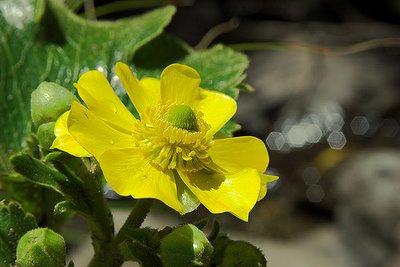 and as I did so I glanced down at the ground next to me. I was sitting next to a rotting possum carcase.
and as I did so I glanced down at the ground next to me. I was sitting next to a rotting possum carcase.
We stayed two nights at Waterfall Hut, then climbed back over to Pourangaki in the heat and wind of another perfect day. Yes, the views lacked the mystery of the first five days, but in their own way they held another kind of possibility—that of distance. On the eastern side of the ridge above Pinnacle Creek there’s a benched area, a perfect place to relax and brew up and eat lunch, or even camp if you’re inclined to do that. We stopped there for lunch, as it was sheltered from the wind and offered the best views imaginable of the central Ruahine. Rangi Saddle, Te Atuaoparapara, Tussock Creek, Broken Ridge, Ohuinga... up North, ridge after ridge, receding into the blue-hazed distance. This time it wasn’t mist, cloud and rain that hid the secrets of the land; it was the land itself and the vagueness of distance, like old, dim memories. You think you recognise a valley where you once walked, but that was years ago; the valley’s changed; what does it look like now? How has it changed? What new stories does it hold? You realise you know next to nothing about it—you walked it once, or a few times, but it’s old; older by far than the history of humans here, and all but a minute fraction of its countless stories will remain forever inaccessible to you. Its knowledge is Orphic and all you can do is be silent and listen.
Suddenly, John points. “Falcon!” he says. Looking down, I see it wing around the curve of the steep spur and disappear.  Later, we hear the hard chatter and see the bird fly back across the gully; hearing the sound behind me also, I look up and see a second bird sailing over the ridge, the unmistakeable silhouette with its long tail and angled wings dark against the bright sky. On the descent, another bird flushes from the near the track and alights nearby on the leatherwood; it’s a falcon, karearea, but we have no way of knowing whether it’s one of the two we’ve already seen. John sees another further down; it’s much lower, well below the bushline, flying up the valley. That makes five sightings with definite confirmation of two individual birds and a high probability of a third.
Later, we hear the hard chatter and see the bird fly back across the gully; hearing the sound behind me also, I look up and see a second bird sailing over the ridge, the unmistakeable silhouette with its long tail and angled wings dark against the bright sky. On the descent, another bird flushes from the near the track and alights nearby on the leatherwood; it’s a falcon, karearea, but we have no way of knowing whether it’s one of the two we’ve already seen. John sees another further down; it’s much lower, well below the bushline, flying up the valley. That makes five sightings with definite confirmation of two individual birds and a high probability of a third.
Half past six in the evening at Pourangaki Hut. From time to time I interrupted my writing to check the venison simmering on the MSR while John had gone up the track to see whether any deer had emerged onto the slip downstream. We had just one day left and tried not to think about it, but it arrived anyway. We had the whole day to walk out, and despite still-heavy packs our fitness had improved substantially, so we stopped frequently to enjoy where we were and delay the inevitable arrival at the car. The closer we got to the road end, the more we stopped and the longer we rested. We ate lunch in a sheltered hollow on the Whanahuia with the incessant hiss of the spring wind through deep snowgrass and a long bank of dazzling white snow slowly turning to slush. Again, it was a day of huge views: blue-grey, distant ridges and valleys; a pale half-moon fixed in a cerulean sky above a lion-coloured skyline. But when we looked out towards the low hills of the Rangitikei farmland, the land looked diseased: infected and scarred with innumerable slips, mostly the aftermath of the February 2004 ‘rainfall event’ but essentially the consequence of human activities that still haven’t attained a sustainable relationship with our land. 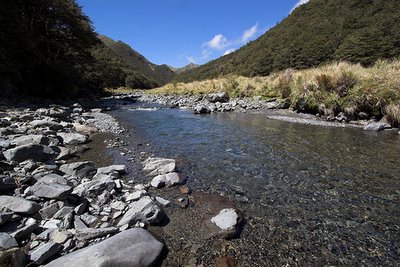 Many good people are working hard to solve those problems and many good people are trying hard to manage that land in the best ways they know, but the inadequacy of those efforts confronted us clearly as we looked out from the high Ruahine. During our 8-day walk, John and I often talked about what might loosely be termed ‘environmental’ as well as social justice issues—how to live ethically, respecting and looking after the world and the people who live in it and are part of it. We speculated about what the future might bring and what motivates people to act irresponsibly or unsustainably regarding the use of resources (in the broadest sense) and towards each other. Being of similar minds, we felt at ease inveighing against various economic and political systems, although we both recognised the futility of levelling any such criticisms in any company other than the already-converted. In that aspect, our discussions were in part just letting off steam.
Many good people are working hard to solve those problems and many good people are trying hard to manage that land in the best ways they know, but the inadequacy of those efforts confronted us clearly as we looked out from the high Ruahine. During our 8-day walk, John and I often talked about what might loosely be termed ‘environmental’ as well as social justice issues—how to live ethically, respecting and looking after the world and the people who live in it and are part of it. We speculated about what the future might bring and what motivates people to act irresponsibly or unsustainably regarding the use of resources (in the broadest sense) and towards each other. Being of similar minds, we felt at ease inveighing against various economic and political systems, although we both recognised the futility of levelling any such criticisms in any company other than the already-converted. In that aspect, our discussions were in part just letting off steam.
But they were also explorations; one thought leading to another; seldom opposing in the all-too-common, confrontational dialectic. I realised that in some ways these sorts of exploratory discussions, although superficially easier than the usual dialectic form, were actually more difficult. The challenge wasn’t to find a counterargument or opposing example but to seek potentially productive connections with other ideas; to find examples and analogies that create new ideas: in particular, to be open to and alert for insights. In these sorts of discussions there’s a kind of constructive tension between allowing your thoughts to wander widely (and wonder widely, too) and keeping them sufficiently focused. Of course, if you want to stay firmly fixed on a topic, these discussions will drive you crazy. But if your discussion is more akin to a conversation, then explorations seem to me to be not just more interesting, but more useful. After all, it’s in the nature of explorations to lead to discoveries—discoveries all the more interesting because you so often have no idea what you might find. I guess you might call it the joy of uncertainty.
 Sometimes light like this makes the world seem old. Older than your childhood, when anything seemed possible, before you knew the names of all the birds in the little valley where you grew up, before you realised the small caves led nowhere and contained nothing but dust and dry sheep droppings; when you never knew the limits of what you might find. Sometimes that grey, dense light with its occasional shafts of yellow sunlight seems so old it’s prehistoric. You know it’s not possible but you keep looking out to sea because those wheeling shapes might have been pterosaurs, soaring over a school of amoured fish. You can almost see them, there, on the fringe of the present, not quite breaking through.
Sometimes light like this makes the world seem old. Older than your childhood, when anything seemed possible, before you knew the names of all the birds in the little valley where you grew up, before you realised the small caves led nowhere and contained nothing but dust and dry sheep droppings; when you never knew the limits of what you might find. Sometimes that grey, dense light with its occasional shafts of yellow sunlight seems so old it’s prehistoric. You know it’s not possible but you keep looking out to sea because those wheeling shapes might have been pterosaurs, soaring over a school of amoured fish. You can almost see them, there, on the fringe of the present, not quite breaking through.  Before dawn a morepork begins to call right outside the window, so loud it wakes me; so loud only logic tells me it isn’t in the room. Light from the street lamp filters through the old curtains, filling the room with shadows and pale shapes the way the full moon illuminates a room full of dreams. I lie half awake, listening, smiling. Dreaming.
Before dawn a morepork begins to call right outside the window, so loud it wakes me; so loud only logic tells me it isn’t in the room. Light from the street lamp filters through the old curtains, filling the room with shadows and pale shapes the way the full moon illuminates a room full of dreams. I lie half awake, listening, smiling. Dreaming. I turned over and went back to sleep, which seemed to be his cue. Having snubbed me all night, he suddenly materialised from a vapour of purring and started walking back and forth next to the mattress, wiping his tail across my face. I reached out, still half asleep, and ran my hand along his back. He moved away but the purring got louder. I opened my eyes and found myself looking straight at his unwashed arse.
I turned over and went back to sleep, which seemed to be his cue. Having snubbed me all night, he suddenly materialised from a vapour of purring and started walking back and forth next to the mattress, wiping his tail across my face. I reached out, still half asleep, and ran my hand along his back. He moved away but the purring got louder. I opened my eyes and found myself looking straight at his unwashed arse. 






